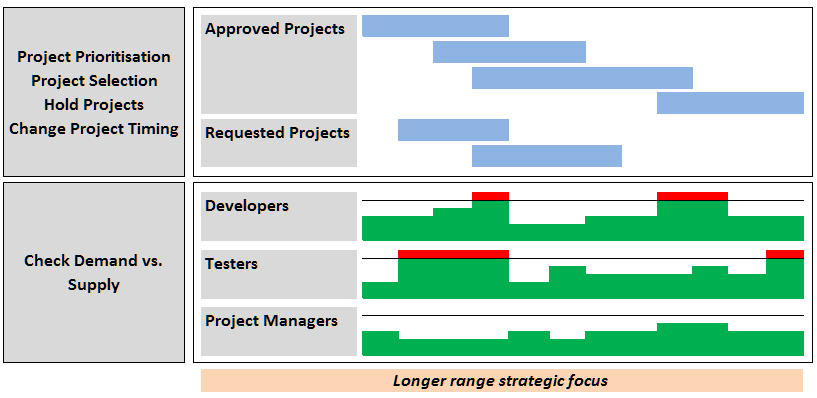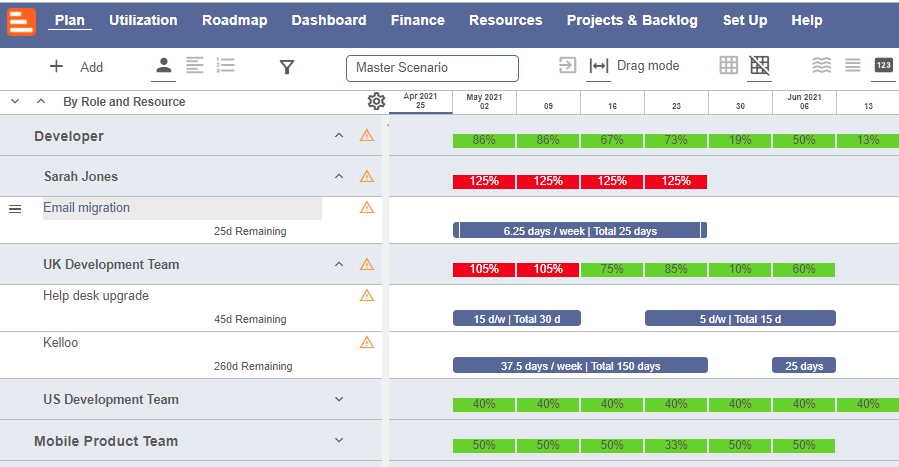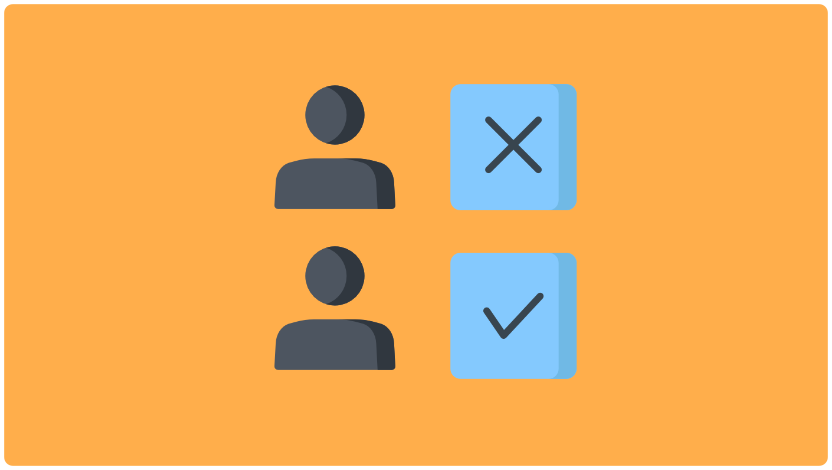
Capacity planning and resource planning are not the same thing. While the terms are often used interchangeably they are different processes with different aims and outcomes.
And do you know what?
You probably need to be doing both resource planning and capacity planning to get your resource management machine working smoothly.
So let me show you the differences between capacity and resource planning and walk you through some simple actionable steps to get these resource management techniques working for you.
Let’s get busy.
Table of contents
Simple changes to your resource management can really shift the needle on your project outcomes. Refining your capacity planning and resource planning process is a good place to start.
Capacity planning vs. resource planning
Capacity planning involves trying to balance the future needs (or demand) for resources against the capacity (or supply) of your resources. So it helps answer long range questions such as:
- What projects should we be doing and when can we do them?
- Do we need to hire more people?
- Do we have the right mix of skills onboard?
While resource planning has a short term focus and is used to make decisions about how resources should be allocated to projects.
And why is this important?
There are many causes for project delays and overruns, but a recurring theme is poor resource management.
And here is something scary:
In a recent PMI survey, respondents reported that poor resource management practices contributed to nearly 25% of all projects deemed a failure.
PS. If you want to take a deeper dive into the topic, our Ultimate Guide to Resource Management is a good place to start.
Kelloo's resource management tools
Resource planning, forecasting and reporting in one place. We help you get the most from your projects and people.
What is capacity planning?
To help explain what capacity planning is and how to do it, we use some example screenshots from the Kelloo resource management software.
Capacity planning is a resource management process that helps you determine if your organization has sufficient resources with the right skills to execute the projects you want to do.
It is a high level process that looks at all the work you are being asked to do, compares this to the resources you have available and helps you decide which projects you can do and when. Capacity planning often forms part of the portfolio management activities in an organization.
Alternative names for capacity planning include resource forecasting and demand planning.
1. Capacity planning compares demand to resource supply
The terms demand and supply are used a lot in resource management, so let’s start by clarifying what these mean.
- Demand is all the work your resources are being asked to do. This could be projects, ad-hoc work or business as usual activities.
- Supply means the supply of your resources in terms of the skills they have and how much labor time they provide your organization.
All organizations are resource constrained (have limited resource supply).
But are able to generate almost unlimited ideas for new projects (unlimited resource demand).
And the problem?
You can’t do everything.
So capacity planning is used to help you balance and manage these competing tensions.
Capacity planning helps you make decisions about which projects you can approve, if you need to hire more resources or if you need to defer or re-schedule lower priority projects.
If you use Kelloo for resource management, the resource heat-map shows if you have a miss-match between resource demand and supply and which roles are in trouble.

Another useful way to analyze capacity vs demand is using a capacity chart. This lets you easily see periods when the resource requirements from your projects exceed your resource capacity.

2. Capacity planning requires setting clear priorities
Capacity planning forces your team to think about priorities and what can be achieved with the resources available in your organization.
This means making tough decisions about which projects you can approve and run. You need to prioritize your projects so you can focus your resources on the initiatives that will provide the most value to your organization.
By prioritizing your projects and then backfilling your resources against your highest priority work it becomes easy to spot what projects you don’t have the resource capacity for.
With Kelloo you just drag your projects into priority sequence and it will automatically work out which projects you can fit it based on your resource capacity.

High level prioritized capacity plan – drag to set priorities
3. The levers you can pull when capacity planning
The resource capacity of most organizations is relatively fixed. This means capacity planning mostly involves managing the demands being made on your resources.
Here are some tactics you can use to balance your capacity plan:
- Change the priority of projects or drop lower priority projects altogether.
- Defer or postpone projects into periods when you have resources availability.
- Hire additional resources or re-allocate resources from lower priority projects.
4. Capacity planning is high level and strategic
To keep your capacity planning simple, you need to analyze your capacity plan at the team or skill level and not by analyzing individual resources.
Which means for example comparing how many project managers you need for your projects vs. how many you currently have.
Your capacity plan should also look far enough into the future to give you time to recruit and onboard resources and to give your organization a heads up as to what projects they are planning on starting up over the coming months.

Capacity planning has a long term strategic focus and compares resource supply to demand
5. Capacity planning involves trade-offs
Capacity planning involves making decisions about the allocation of resources to meet project demands. However, like any decision-making process, it requires trade-offs to balance conflicting objectives and constraints. To understand the likely impact of these trade-offs use what-if analysis.
What-if analysis in resource management is like a crystal ball for decision-makers. It lets you explore different scenarios to understand the potential impact of changes in resource levels, allocations, resource utilization, or cancelling or deferring projects.
What is resource planning?
First let us unravel what resource planning is.
Resource planning is a resource management process used to coordinate and allocate actual resources to projects.
Contrast this to resource capacity planning which is a technique used to decide which projects you have the capacity to run.
In most project based organizations, resources are people so it involves identifying the best team of people for each project and working out when they can work on the project.
An alternative name for resource planning is resource allocation.
1. Resource plan pre-requisites
Before you can create your resource plan, there is some information you need to pull together.
The first is a breakdown of the skills the project manager needs.
Ideally, the project manager should not ask for specific resources – they should list the skills needed and leave it to the resource manager to decide who best fits the role.
You will also need to know the duration of the different assignments in the project. So for example the project manager may need four software developers for six months and one designer for two months.
2. Resource planning involves balancing resources across projects
In an ideal world, resources would work on one project at a time. This would make the resource managers life easy and negate the need for resource planning.
However in the real world:
Resources shared across multiple projects is a fact of life and resource planning gives us a solution to the challenges this poses.
As you allocate resources to projects you need to keep tabs on the resource utilization of your resources and spot teams, skills or individual resources that are becoming hot spots.
Resource utilization is a key metric as it analyzes all resources and all projects to report the status of the resources. Resource conflicts are instantly highlighted so remedial action can be taken.

The Kelloo resource plan includes all the projects you are working on – including agile work
3. Resource planning is near term and resource based
Unlike capacity planning where the focus is skills, resource planning shifts the focus to individual resources.
And whereas capacity planning looks long term, resource planning normally looks no further than the next few months.
And this is important.
Change happens so often on projects (delays, new-priorities, resources leaving) that resource planning is an ongoing process. So trying to organize your resource plan too far into the future is a wasted exercise.
A better solution is to update your resource plan with new estimates and resource requirements from the project managers every few weeks and adjust resources as necessary.
4. Resource planning is difficult without using appropriate tools
As you change the resource plan and allocations for one project this inevitably has knock on effects with other projects and resources.
If there was one piece of advice I could give you…
A good resource planning tool is able to highlight these issues straight away and let you explore solutions to the problem.
Some folks start out using spreadsheets for resource planning but quickly discover they make the process error prone and over complicated.
Resource planning tools are worth the small investment for the upside you get in your resource management. They provide an out of the box template for resource planning that can be up and running in minutes.
Resource and capacity planning software
Let us step through a few features in Kelloo so you can see how a dedicated resource management tool can make your life easier when resource planning and capacity planning.
#1 Clear visibility of what is happening when and your priorities
The planner in Kelloo is where you set your project priorities and schedule when you want work to happen. Simply drag and drop projects and work to adjust priorities and the timing of work.
The planner includes all projects in your portfolio meaning you can easily see the impact changes have on other projects and your resources.
Kelloo supports planning any type of project. So whether you run agile projects, traditional waterfall projects or a mix of both – Kelloo has it covered.

Prioritize your projects
#2 Utilization reporting and analysis
At the foot of the planner is the utilization heatmap which shows the utilization of your skills, teams or resources. As you make changes in the planner, the heatmap is instantly updated.
In the example below, as we change the allocations in the top window watch how the utilization heatmap in the bottom window changes.

See the impact of changes instantly on the heatmap
#3 Searching for resources or replacing resources
If you need to search for a resource or swap a resource Kelloo lets you search for candidates with the same skills and review their availability to take on the work. You can even analyze the impact of assigning the work to different resources before you commit.

Check availability of resources
#4 Evaluate different resource plan alternatives
When it comes to resource planning there are always different alternative solutions to explore. In Kelloo you can have different versions of a resource plan (we call these scenarios) that you can compare to find the best outcome for your resources and project timescales.

Evaluating different resource plan options
Conclusion
While the results of the capacity planning process feed directly into the resource planning process, it is key that the differences are understood. Get your resource planning and capacity planning working in harmony and you will create a solid platform for managing resource allocation in a multi project environment.
Here is a summary of the key differences between capacity planning and resource planning.








